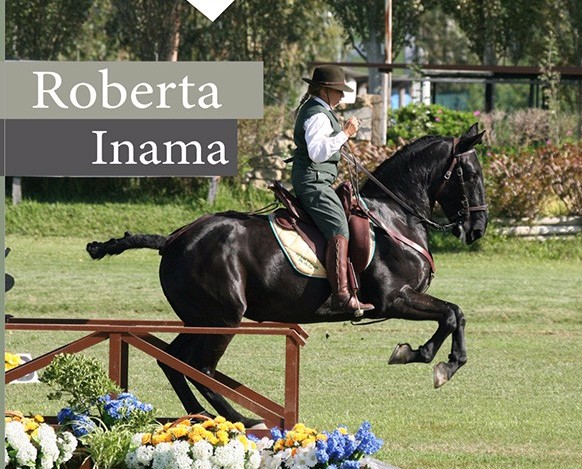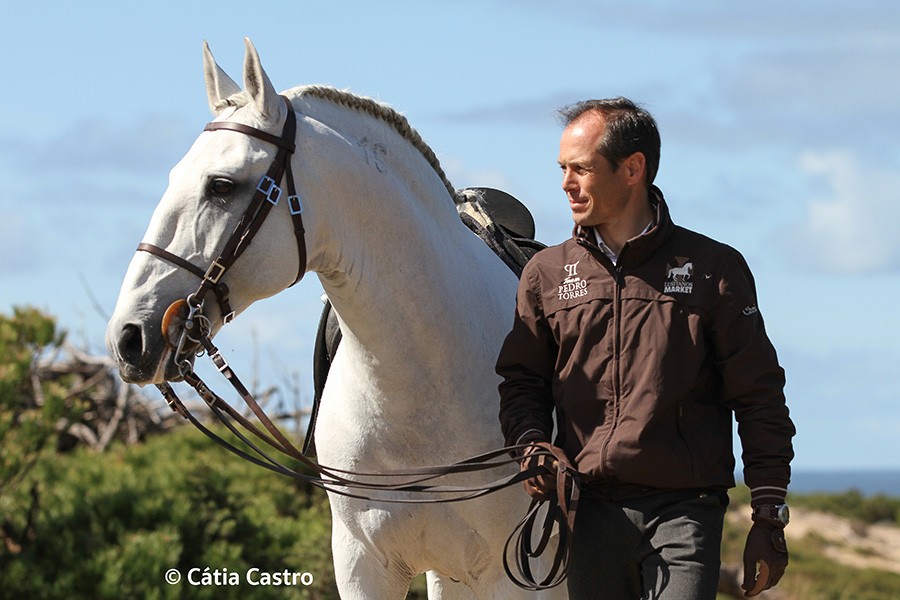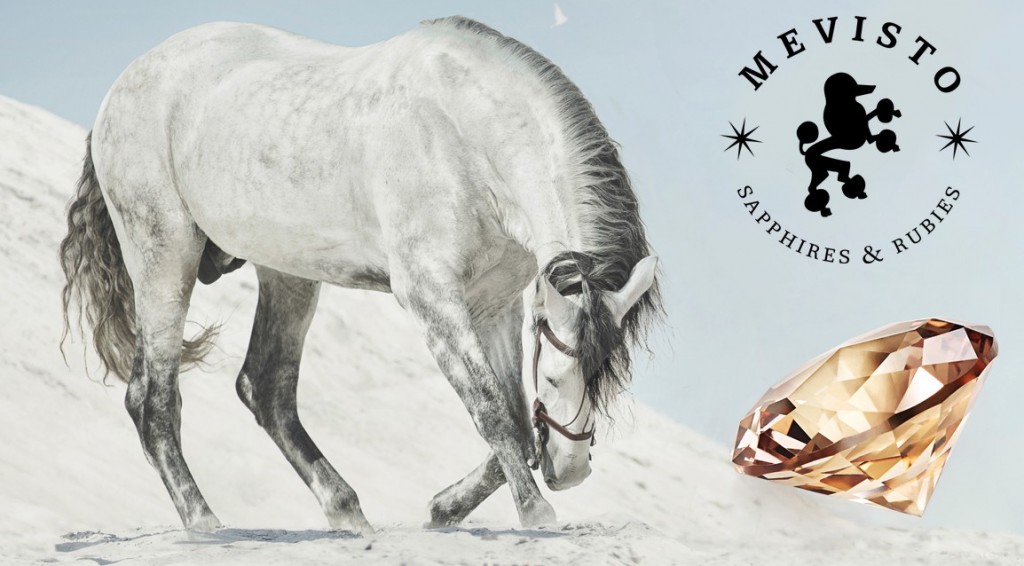
Working Equitation champion Roberta Inama
Interview with Roberta Inama
by Jessica Morton
There is a dusky aura to the Ligurian countryside in the early morning. The rolling hills are softer at this time of the day, and it is now that the region demonstrates best its celebrated romantic ambiance. It is late in January when I decide to drive out from Florence to the flood ravaged Ligurian region to meet two influential Murgese horse trainers, and discover what their black horses can offer modern recreational and competitive riders.
Chiusola is a tiny village located in the Apennine mountains. Standing guard over a densely forested topography, the lure of the Ligurian Apennines is that the villages up here feel authentic, without any of the obvious tourist trappings that plague the nearby Cinque Terre. The old streets and stone houses have remained almost exactly the same as a thousand years ago- the streets are calm and one can smell the soft scent of Marsiglia soap lingering in the air.
Michelangelo Boer grew up in this small mountain village. An accomplished horseman, he developed a fascination with the Murgese horse in the late 1980’s after reading an article that praised the breeds hardiness and aptitude for trekking. At the time Michelangelo was looking for a low maintenance trail horse that could handle living outside during the cold winters and work during the summer as a trail horse at his riding center. Up here the thick forested surroundings are home to wolves, wild boar, eagles and deer. The terrain is challenging; steep and craggy. To handle this unforgiving landscape and the extreme weather – the horses need to be tough. A visit to Puglia convinced him that the Murgese was what he was looking for. A strong and hardy horse, that was also versatile.
Michelangelo met Roberta Inama, a local dressage rider from nearby La Spezia. With their combined equestrian knowledge and experience they worked together to breed and produce exceptional Murgese horses for a variety of disciplines from long distance trekking through to dressage and eventually Working Equitation.
 Roberta and her brilliant mare ‘Macina’ have promoted the breed internationally through Working Equitation. At the 2006 World Championship in Lisbon, the little blond Inama and her powerful black horse achieved a team medal (bronze), and in 2009 the pair participated at the German Bentaiga Trophy in Germany where they took away two gold medals in dressage and the Completo title (for all four trials).
Roberta and her brilliant mare ‘Macina’ have promoted the breed internationally through Working Equitation. At the 2006 World Championship in Lisbon, the little blond Inama and her powerful black horse achieved a team medal (bronze), and in 2009 the pair participated at the German Bentaiga Trophy in Germany where they took away two gold medals in dressage and the Completo title (for all four trials).
I meet Roberta in the village. The rain has stopped for the moment, so we decide to head straight up to the stables while the weather holds out. Michelangelo picks us up in the farm truck, and we are followed up the road by the couples big white sheepdog.
The Murgese stallion lines can produce an outstanding variation of type suitable for a wide selection of equestrian pursuits. Roberta and Michelangelo are quick to point out that why they consider this an attribute of the breed. “Murgese horses were bred by nobility. Their were horses for different purposes – and even today at the annual sales you can find a very diverse range of horses for sale”.
To demonstrate the different types they bring out each of the horses they currently have in training and release them in the arena.
Adone is first up. A black stallion with an unmistakably baroque profile. Roberta sends him off and works him at liberty in the arena. He is not a big horse – but exudes a very special presence when he moves. “This is an excellent classical dressage horse” Roberta tells me. As they leave the arena Adone bounds over a small cross pole on the ground. “Its not true when people say that Murgese cant jump”, jokes Michelangelo behind her.
Aurora is next. This pretty 17hh dressage mare reminds me of a Westphalian gelding I once worked with. This mare competes with a 14 year old rider and recently took out the silver medal at the regional dressage championships, proving not only the wonderful nature of the Murgese, but also their athletic capability.
Troiano and Beniamino are next up. Troiano is Roberta’s dressage mount. He dances about the arena excitedly and then runs up to Michelangelo and Roberta who show me how he can bow down at liberty.
Interestingly the couple have also sold on horses which have became famous in equestrian perfomance shows – and watching the beautiful Troiano work for them in harmony and complete liberty, I can understand why.
Beniamino is a young horse that has recently been sold as a trekking mount. After watching the gelding in the arena, I tell Roberta that its a shame hes not going to be used in dressage. Michelangelo laughs that with the market the way it is – the fact he has a good home is what is important.
Violante enters the arena with head held high and nostrils flared. She is a statuesque mare with a fiery personality, not at all for the faint hearted. Roberta had hoped she would be suitable for Working Equitation, but is now swaying towards dressage as she is too highly strung for the latter. As Violante tears around the arena showing off her remarkable movement. I ask Roberta whether she was a bucker. Roberta grins and Michelangelo laughs. “Not anymore” she tells me. Michelangelo watches the mare and tells me “There are butteri (Tuscan cowboys) that would give their right arm for a mare like this. Unfortunately she just didn’t have the consistency for Working Equitation”.
 Next up Roberta brings out Bruno Rinaldi, a young stallion. He is in her eyes the ideal working equitation type. Rinaldi’s compact conformation is very similar to the Napolitano horse of old. His stature and movement is exemplary of the type of horse required to swap between working cattle to classical dressage. He is quick and agile on his feet, yet level headed. The majority of horses competing internationally in working equitation are classical working horses, predominately the Lusitano, PRE and Lipizzaner. “Precision and speed are important, but if you don’t have a horse that’s sensible in the head, than its all over. This is what lets down many riders. The riding is good, but the horses cant always be counted on”. Michelangelo explains, “We have high hopes for this horse. Roberta adds. He’s small for a Murgese, but look how well put together he is. Tall horses don’t usually do well in Working Equitation anyway”. She adds.
Next up Roberta brings out Bruno Rinaldi, a young stallion. He is in her eyes the ideal working equitation type. Rinaldi’s compact conformation is very similar to the Napolitano horse of old. His stature and movement is exemplary of the type of horse required to swap between working cattle to classical dressage. He is quick and agile on his feet, yet level headed. The majority of horses competing internationally in working equitation are classical working horses, predominately the Lusitano, PRE and Lipizzaner. “Precision and speed are important, but if you don’t have a horse that’s sensible in the head, than its all over. This is what lets down many riders. The riding is good, but the horses cant always be counted on”. Michelangelo explains, “We have high hopes for this horse. Roberta adds. He’s small for a Murgese, but look how well put together he is. Tall horses don’t usually do well in Working Equitation anyway”. She adds.
Macina, Roberta’s star mare and winner of the Betaiga trophy in 2009 is a sweet mare that demonstrates how talented she is in a liberty demonstration of Spanish walk with Roberta – it is real privilege for me to watch this equine/human partnership – well known amongst working equitation and Murgese enthusiasts.
It is touching to hear how Macina was in a box all alone when Roberta found her. Even then there was something special about the little mare – and that spark turned into a successful partnership that is still evident today even though Macina has been out of work due to injury for two years. Macina has done more for the promotion internationally of the Murgese horse than any other example. This was the horse that made it onto the European Working Equitation competition circuit, and proved to the world the versatility of the breed.
It is apparent with all the horses here, that the temperament is generically good, even the excitable Violante comes up to me twice when free in the arena. These are horses that seek human contact. This is a testament to their trainers since the horses often arrive terrified of humans.
“They arrive virtually un-handled. The mares don’t get touched at all” Roberta tells me. “Its survival of the fittest down there. The stallions get it worse. Castration is non existent. As soon as they are start causing trouble in the herd, they are closed up in a box.
Aristotle, a handsome little gelding used as a first horse by a seventy year old woman leans out of his box for some attention. “He was one of the worst when he arrived”, Roberta tells me. They can tell the difference though. Like an abandoned dog that has been kicked around all its life, they can draw a distinction between a kind hand and a violent one”.
The rain by this stage is falling hard, so we decide to put the horses away and retire to the farmhouse, where over a plate of Genovese Pesto pasta, we enter an interesting discussion on Working Equitation here in Italy.
Working Equitation, or Monta da Lavoro began in Italy after an organized competition was held between the Butteri of Tuscany on their Maremmano horses and the French Camargue cowboys on their native mounts. Today Italy as a team is traditionally highly competitive in the speed and cow trials but still relatively weak in the dressage trial.
“Working equitation competitions have been a good learning curve for us” Roberta tells me. “We now realize we need to improve our horses basic training and its been good to compete against other countries like Portugal to better understand the holes in aspects of our schooling. The Italian team has good riders; fast and fearless. We excel at the speed trial and work cattle well – but we need to work on refining our riding and training system as this is what is holding the team back.”
“We are not as organized as a team compared to some other countries ”she says, adding that she believes Germany will become extremely competitive in the future.
“Its still a new sport in Germany. But they are extremely dedicated and they have good support for the discipline which is something our team doesn’t have. I believe they will move up the ranks quickly”. Interestingly a German rider is competing in working equitation with a Murgese horse too.
When I ask why the Murgese makes a good Working Equitation mount, Roberta answers:
“These are horses raised amongst cattle in Puglia, so cow sense is bred into them. The quick agile movements that were once important on the battlefield, and the dependable personality, make the breed suitable for each of the four working equitation phases.” Roberta and Michelangelo both state the importance of a level headed horse in this sport. “You can have everything else; speed, elegance etc – but if your horse looses his head, then he’s never going to go far”.
Roberta and I discuss how to best publicise the Murgese horse for modern riders. She tells me “Its a case of reinventing a warhorse into something marketable for the 21st century. The popularity of Working Equitation internationally has  promoted the Lusitano horse immensely, and I hope the same will occur with the Murgese. The Murgese, like the Lusitano was a war horse. War horses needed to be fast and agile, yet steady under pressure. The Murgese is ideal for various equestrian pursuits – be it trekking in the mountains, classical or traditional dressage, or Working Equitation. There is a great selection of registered horses available and this in itself is a great marketing attribute for the breed.”
promoted the Lusitano horse immensely, and I hope the same will occur with the Murgese. The Murgese, like the Lusitano was a war horse. War horses needed to be fast and agile, yet steady under pressure. The Murgese is ideal for various equestrian pursuits – be it trekking in the mountains, classical or traditional dressage, or Working Equitation. There is a great selection of registered horses available and this in itself is a great marketing attribute for the breed.”
As I am about to leave a deep rumble causes Michelangelo to leap to his feet and yell for us to get out of the house quick. “Earthquake”. We all run outside, and later I find out that we were located right at the epicentre of a 5.4 earthquake.
We say our goodbyes then as Roberta and Michelangelo jump into their truck to go and check the horses are OK. Luckily it turns out that the quake caused no damage.
I drive home thinking about these wonderful black horses, and how fortunate I was to see a selection of different examples of the breed in such an enchanting location. Michelangelo and Roberta are two very particular horse people, as they have realised the importance of not only good breeding, but also in good training and promotion of the Murgese horse under saddle. Whether it is out on a mountain trail ride, or competing at regional dressage competitions – the Murgese can self promote itself, but it really does need to be seen to be believed.





